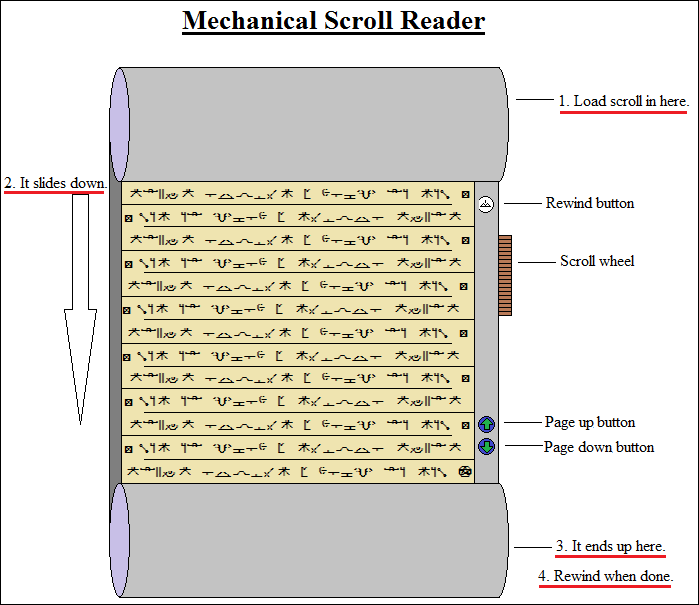Traipah invention: Mechanical scroll reader.
I was thinking, the other day, about how Traipah has three different formats for writing:
1. Book format, which starts at the "back" of the book (as we Westerners would figure things), moving toward the "front," the book turned "on its side." Then the actual writing starts at the bottom right of the page, moves upward, then when you get to the top of the line, you continue at the bottom of the line to its left.
2. Sign format, wherein they write important signs top-down, right-to-left.
3. Scroll format, which starts at the bottom right of the scroll, and moves in a boustrophedon upward to the top.
This got me thinking about how their books are designed, and why scrolls are still popular with them. And I came up with two things:
1. Their books are bound differently from ours. Their books are spiral bound. At least one cover of the book is hard. You hold the book by the cover with one hand, and turn the pages with the other. If both covers were hard, you could set the book up on its covers to free up one hand.
2. Scrolls are still highly popular on Traipah because of the invention, at some point, of a mechanical scroll reader. Hold with one hand, or set it down, and scroll the scroll with the scroll wheel:

The sample text on the picture just says "This is only a sample text," over and over again. (It is also difficult to read.) I think the scrolls made for the mechanical scroll readers are made of some kind of plastic or other tough substance that's flexible but able to take the beating of multiple un-windings and re-windings.
Then when digital paper was invented, a new digital scroll reader was invented, with a continuous loop of a single sheet of digital paper. The computer in the reader loads the text onto the digital paper as you scroll, so it's basically an e-reader. (Digital paper is paper made of nanites, which can store hundreds of terabytes of data just on its own.)
All published Traipahni books are published in all of the common formats, with physical copies of both books and scrolls archived in the Sahn-Kusahn library, and other libraries.
This was cross-posted from http://fayanora.dreamwidth.org/1076276.html
You can comment either here or there.
1. Book format, which starts at the "back" of the book (as we Westerners would figure things), moving toward the "front," the book turned "on its side." Then the actual writing starts at the bottom right of the page, moves upward, then when you get to the top of the line, you continue at the bottom of the line to its left.
2. Sign format, wherein they write important signs top-down, right-to-left.
3. Scroll format, which starts at the bottom right of the scroll, and moves in a boustrophedon upward to the top.
This got me thinking about how their books are designed, and why scrolls are still popular with them. And I came up with two things:
1. Their books are bound differently from ours. Their books are spiral bound. At least one cover of the book is hard. You hold the book by the cover with one hand, and turn the pages with the other. If both covers were hard, you could set the book up on its covers to free up one hand.
2. Scrolls are still highly popular on Traipah because of the invention, at some point, of a mechanical scroll reader. Hold with one hand, or set it down, and scroll the scroll with the scroll wheel:

The sample text on the picture just says "This is only a sample text," over and over again. (It is also difficult to read.) I think the scrolls made for the mechanical scroll readers are made of some kind of plastic or other tough substance that's flexible but able to take the beating of multiple un-windings and re-windings.
Then when digital paper was invented, a new digital scroll reader was invented, with a continuous loop of a single sheet of digital paper. The computer in the reader loads the text onto the digital paper as you scroll, so it's basically an e-reader. (Digital paper is paper made of nanites, which can store hundreds of terabytes of data just on its own.)
All published Traipahni books are published in all of the common formats, with physical copies of both books and scrolls archived in the Sahn-Kusahn library, and other libraries.
This was cross-posted from http://fayanora.dreamwidth.org/1076276.html
You can comment either here or there.